Sumitomo Rubber Industries Bundle
Can Sumitomo Rubber Industries Revitalize its Global Footprint?
Sumitomo Rubber Industries (SRI), a titan in the tire industry, is aggressively pursuing a robust growth strategy to solidify its position in a competitive market. With a history dating back to 1909 and a global presence spanning numerous production facilities, SRI is poised for significant transformation. The recent re-acquisition of the Dunlop brand rights is a key move, signaling ambitious plans for expansion and market share gains.
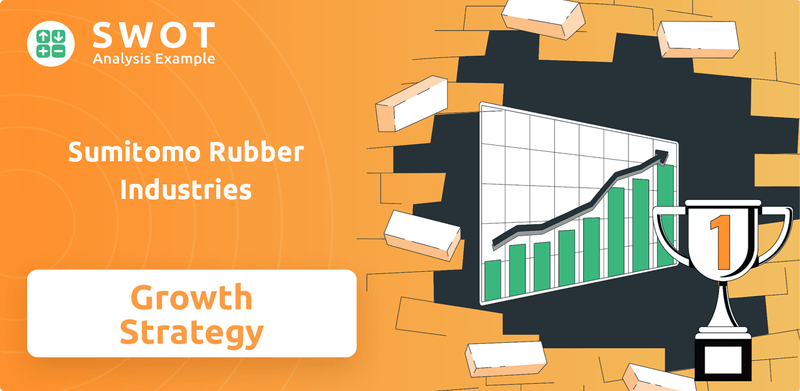
This Sumitomo Rubber Industries SWOT Analysis delves into SRI's 'RISE 2035' strategy, aiming to double its operating profit margin. We'll examine the company's innovative approaches and how it navigates the dynamic tire industry. Understanding SRI's Growth Strategy and Future Prospects is crucial for investors and analysts seeking to understand the Company Analysis and potential opportunities within the sector, including the impact of the Tire Industry on Sumitomo Rubber Industries and its overall performance.
How Is Sumitomo Rubber Industries Expanding Its Reach?
Sumitomo Rubber Industries (SRI) is actively pursuing several expansion initiatives to drive future growth, particularly focusing on leveraging its re-acquired global Dunlop brand rights. The company's strategy, outlined in 'RISE 2035', aims to increase its market share and profitability within the tire industry.
A key element of this strategy is the premiumization of its tire offerings. SRI plans to increase the proportion of premium tires to 60% of total tire sales by 2035, up from the current 40%. This will be achieved primarily through accelerated sales of Dunlop globally and Falken in North America. This strategic shift is designed to enhance both profitability and the company's overall market position.
Geographically, the Dunlop acquisition is expected to boost sales in North America and Australia in 2025. The company is also increasing its production volume, with a projected 6% rise in fiscal year 2025. Notable growth is anticipated in its Japanese and European operations. Despite a first-quarter 2025 production volume at 98% of the previous year's level, the company anticipates an annual production of 587,000 tons in 2025.
SRI is expanding its retail network to support its growth strategy. The UK retail division, Protyre, is aiming to double its number of fast-fit garages by 2025. This expansion will enhance SRI's market presence and improve customer service capabilities.
SRI is committed to building new 'revenue pillars' in non-tire business activities. The company aims for non-tire developments to contribute 30% of its earnings by 2035. This diversification includes expanding capabilities in crumb rubber and growing the plastic recycling business.
SRI's expansion initiatives are focused on increasing profitability and diversifying its business. These initiatives include expanding its tire production capacity and increasing the proportion of premium tires sold.
- Expansion of the Dunlop brand globally.
- Increasing production volume by 6% in fiscal year 2025.
- Aiming for non-tire businesses to contribute 30% of earnings by 2035.
- Expanding the retail network through Protyre in the UK.
Sumitomo Rubber Industries SWOT Analysis
- Complete SWOT Breakdown
- Fully Customizable
- Editable in Excel & Word
- Professional Formatting
- Investor-Ready Format
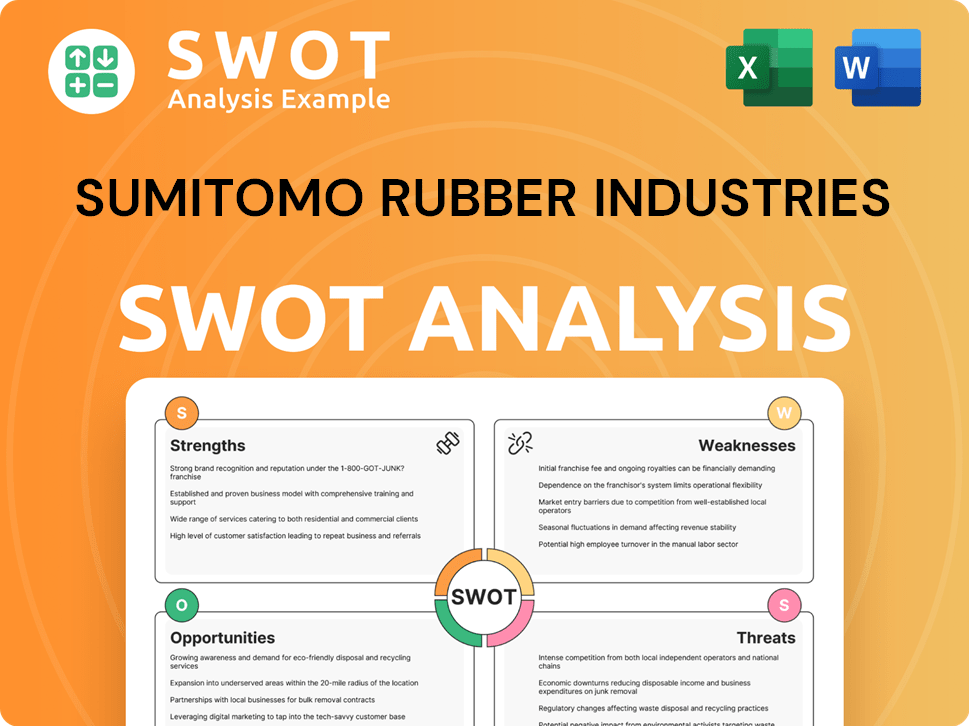
How Does Sumitomo Rubber Industries Invest in Innovation?
Sumitomo Rubber Industries (SRI) is strategically investing in innovation and technology to drive its future growth, particularly through its 'RISE 2035' strategy. This approach focuses on leveraging its core expertise in 'Rubber and Analytical Technology' to create premium products and deliver new experiential value. The company is positioning itself to meet evolving market demands and maintain a competitive edge in the tire industry.
The company's commitment to innovation is evident in its investments in research and development and the establishment of new facilities. This includes an 'innovation lab' in North America, planned for 2026, and a 'quantum computer innovation center' in Japan, expected by 2028. These initiatives are designed to accelerate the development of advanced technologies and products.
SRI is also focused on digital transformation to enhance operational efficiency and speed to market. This involves the adoption of advanced manufacturing execution systems and the integration of data across business and production processes. These efforts are crucial for streamlining operations and adapting to the changing landscape of the tire industry.
SRI is implementing digital transformation initiatives to standardize global plant operations. In December 2024, the company selected Rockwell Automation to deploy the FactoryTalk ProductionCentre MES platform. This rollout begins at the Shirakawa plant in Japan in the second half of 2025, with global expansion planned from 2026.
SRI is developing 'active tread' technology, which allows tires to adapt to road surfaces. They are also creating premium products using new compounding, design, and development process technologies. The 'Sensing Core' tire sensing technology is expanding globally, with full-scale operations in the United States starting in 2025.
Sustainability is a core part of SRI's innovation strategy, guided by its 'Sustainability Vision' and 'Driving Our Future Challenge 2050.' The company aims for carbon neutrality by 2050, including a 55% reduction in Scope 1 and 2 emissions by 2030 compared to 2017 levels. They are also targeting a 25% reduction in Scope 3 Category 1 emissions by 2030 compared to 2021 levels.
SRI is introducing hydrogen production systems at factories and collaborating with Mitsubishi Chemical Corporation to recycle carbon black from rubber chippings and end-of-life tires, with plans to scale up use from 2026. Retread tires are also a key component of their sustainability strategy.
SRI is increasing investments in research and development to support its innovation goals. The establishment of an innovation lab and a quantum computer innovation center demonstrates a commitment to cutting-edge technologies. These investments are essential for maintaining a competitive edge in the tire industry.
SRI's digital transformation and new technology deployments are designed for global expansion. The rollout of the FactoryTalk ProductionCentre MES platform and the expansion of 'Sensing Core' technology in the United States exemplify the company's global growth strategy. These initiatives support Marketing Strategy of Sumitomo Rubber Industries.
SRI's innovation strategy focuses on several key areas, including advanced tire technology, digital transformation, and sustainability initiatives. These efforts are supported by significant investments in R&D and strategic partnerships. The company's goal is to create value through premium products and sustainable practices, positioning itself for long-term growth in the tire industry.
- Active Tread Technology: Development of tires that adapt to road conditions.
- Sensing Core: Proprietary tire sensing technology for enhanced safety.
- Digital Transformation: Implementation of MES platforms for improved efficiency.
- Sustainability: Carbon neutrality by 2050 with emission reduction targets.
- Hydrogen Production: Introduction of hydrogen systems at factories.
- Carbon Black Recycling: Collaboration with Mitsubishi Chemical Corporation.
Sumitomo Rubber Industries PESTLE Analysis
- Covers All 6 PESTLE Categories
- No Research Needed – Save Hours of Work
- Built by Experts, Trusted by Consultants
- Instant Download, Ready to Use
- 100% Editable, Fully Customizable
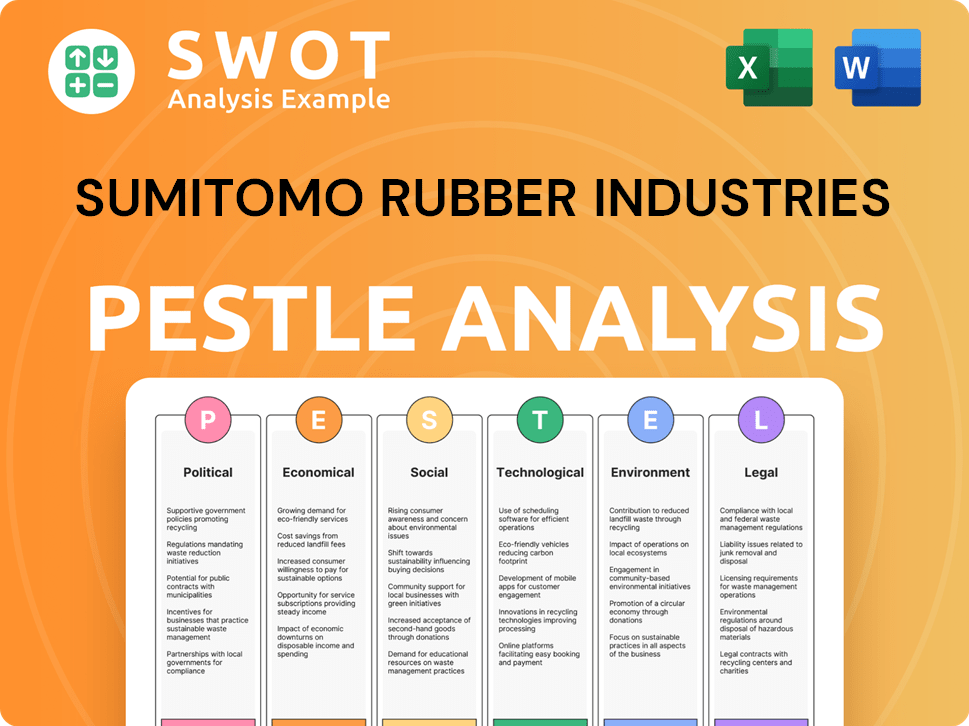
What Is Sumitomo Rubber Industries’s Growth Forecast?
The financial outlook for Sumitomo Rubber Industries (SRI) indicates a positive trajectory, with the company projecting significant growth in fiscal year 2025. This comes after a year of mixed results in 2024, where the company navigated various market challenges. These projections highlight SRI's strategic focus on expansion and profitability within the competitive tire industry.
In 2024, SRI's sales increased by 2.9% to $7.99 billion, with business profit up 13.2% to $581 million. However, net earnings decreased by 73.4% to $65.1 million. Despite these fluctuations, the company's performance in the fourth quarter, driven by strong cost control and favorable exchange rates, allowed them to exceed initial forecasts. This performance sets the stage for the ambitious targets set for the coming fiscal year.
SRI's 2025 forecast includes a revenue increase to JPY 1,220 billion, a 101% increase from the previous year, and a business profit of JPY 95 billion, up 108% year-on-year. Operating profit is expected to reach JPY 84 billion, a substantial 751% increase, with net income projected at JPY 45 billion, a 456% increase from 2024. These forecasts take into account the impact of foreign exchange rates and aim to mitigate the negative effects of US tariff hikes through price adjustments.
SRI reported sales of $7.99 billion, a 2.9% increase from 2023. Business profit rose by 13.2% to $581 million. Net earnings decreased by 73.4% to $65.1 million, while profit attributable to owners was 9.87 billion yen, exceeding initial forecasts.
For fiscal year 2025, SRI anticipates revenue of JPY 1,220 billion, a 101% increase. Business profit is projected at JPY 95 billion, up 108% year-on-year. Operating profit is expected to reach JPY 84 billion, with net income at JPY 45 billion.
The company expects a business profit margin of 7.8% in FY2025. The Return on Invested Capital (ROIC) is targeted at 6.7%, and Return on Equity (ROE) at 7% for the same period, indicating a focus on efficient capital management.
SRI's 'RISE 2035' strategy aims to double the operating profit margin to the 15% range by 2035 and achieve an ROE of 12% long-term, with a mid-term goal of 10% by 2027. This reflects a commitment to sustained growth and profitability.
Capital investment for FY2025 is planned at 35.6 billion yen, an increase from 25.6 billion yen in FY2024, demonstrating a commitment to expansion. Over the past five years, SRI has invested 194 billion yen in capital expenditures. The company also plans an annual dividend of JPY 70 per share for 2025, the highest ever, with a consolidated dividend payout ratio of 40% or more. This dividend strategy reflects confidence in the company's financial health and its commitment to shareholder value. This financial outlook is further supported by the company's core values, as outlined in Mission, Vision & Core Values of Sumitomo Rubber Industries.
Sumitomo Rubber Industries Business Model Canvas
- Complete 9-Block Business Model Canvas
- Effortlessly Communicate Your Business Strategy
- Investor-Ready BMC Format
- 100% Editable and Customizable
- Clear and Structured Layout
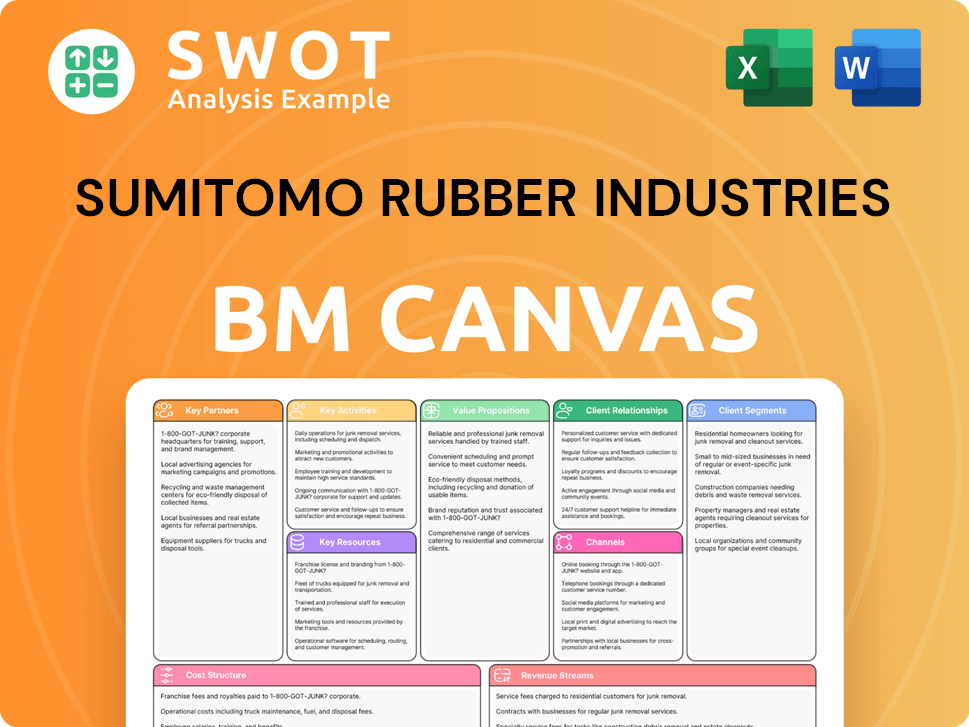
What Risks Could Slow Sumitomo Rubber Industries’s Growth?
Sumitomo Rubber Industries (SRI) faces several potential risks and obstacles that could influence its growth strategy and future prospects. These challenges range from intense market competition and regulatory changes to supply chain vulnerabilities and technological disruptions. Understanding these risks is crucial for assessing the company's ability to achieve its long-term goals and maintain a competitive edge in the tire industry.
The company's strategic planning must account for external factors like economic shifts and internal issues such as operational efficiencies. SRI's ability to navigate these complexities will determine its overall success in a dynamic global market. SRI's strategic planning is crucial for navigating these challenges.
SRI's financial performance analysis reveals the impact of these risks, particularly in areas like profitability and market share. The company's adaptation to these challenges will be a key factor in its future growth trajectory. SRI is constantly adapting to these challenges.
The tire industry is highly competitive, with major players like Michelin, Bridgestone, and Goodyear vying for market share. The industrial rubber products market is projected to reach USD 243.8 billion by 2035, intensifying competition. SRI must differentiate itself to succeed.
Changes in regulations, such as US tariff hikes, can create obstacles for SRI. However, SRI aims to mitigate these impacts through price adjustments and other measures. Adapting to these regulatory changes is essential.
The appreciation of the yen can negatively affect profits, as seen in Q1 2025 with foreign exchange losses. SRI needs to manage currency risks effectively. Currency fluctuations can impact financial performance.
Supply chain vulnerabilities and rising raw material costs pressure margins. SRI projects a negative impact of 10.5 billion yen from raw material costs for FY2025. Managing these costs is critical.
The tire industry is evolving with vehicle electrification, demanding specialized tires. SRI is investing in digital transformation and innovative technologies like 'active tread.' Adapting to technological advancements is crucial.
Internal resource constraints and structural reforms also present challenges. The closure of the Tonawanda, N.Y., plant in November 2024, and the dissolution of Sumitomo Rubber USA LLC, resulted in significant restructuring losses. These reforms are aimed at long-term growth.
SRI addresses these risks through diversification and strategic planning, including the 'Driving Our Future Challenge 2050' policy. This policy integrates sustainability as a core element of risk management. SRI's strategic approach is essential for long-term success.
Despite these challenges, SRI has met its medium-term financial targets ahead of schedule. This demonstrates the company's ability to adapt and manage risks effectively. For more details, you can explore the Competitors Landscape of Sumitomo Rubber Industries.
Sumitomo Rubber Industries Porter's Five Forces Analysis
- Covers All 5 Competitive Forces in Detail
- Structured for Consultants, Students, and Founders
- 100% Editable in Microsoft Word & Excel
- Instant Digital Download – Use Immediately
- Compatible with Mac & PC – Fully Unlocked
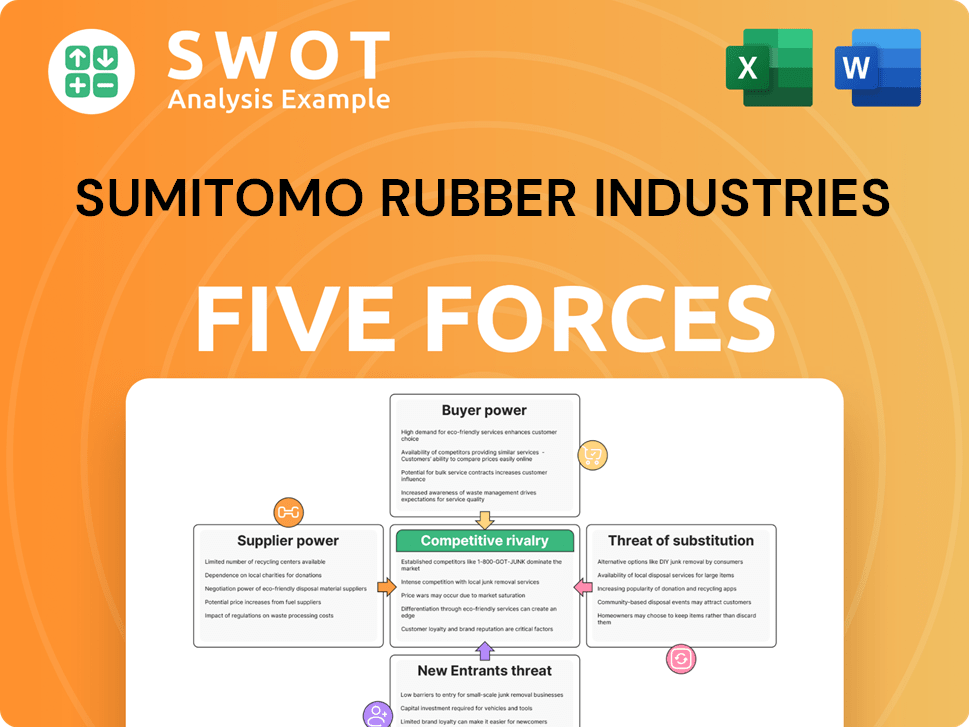
Related Blogs
- What are Mission Vision & Core Values of Sumitomo Rubber Industries Company?
- What is Competitive Landscape of Sumitomo Rubber Industries Company?
- How Does Sumitomo Rubber Industries Company Work?
- What is Sales and Marketing Strategy of Sumitomo Rubber Industries Company?
- What is Brief History of Sumitomo Rubber Industries Company?
- Who Owns Sumitomo Rubber Industries Company?
- What is Customer Demographics and Target Market of Sumitomo Rubber Industries Company?
Disclaimer
All information, articles, and product details provided on this website are for general informational and educational purposes only. We do not claim any ownership over, nor do we intend to infringe upon, any trademarks, copyrights, logos, brand names, or other intellectual property mentioned or depicted on this site. Such intellectual property remains the property of its respective owners, and any references here are made solely for identification or informational purposes, without implying any affiliation, endorsement, or partnership.
We make no representations or warranties, express or implied, regarding the accuracy, completeness, or suitability of any content or products presented. Nothing on this website should be construed as legal, tax, investment, financial, medical, or other professional advice. In addition, no part of this site—including articles or product references—constitutes a solicitation, recommendation, endorsement, advertisement, or offer to buy or sell any securities, franchises, or other financial instruments, particularly in jurisdictions where such activity would be unlawful.
All content is of a general nature and may not address the specific circumstances of any individual or entity. It is not a substitute for professional advice or services. Any actions you take based on the information provided here are strictly at your own risk. You accept full responsibility for any decisions or outcomes arising from your use of this website and agree to release us from any liability in connection with your use of, or reliance upon, the content or products found herein.